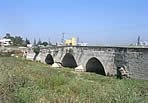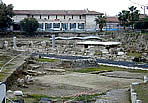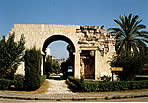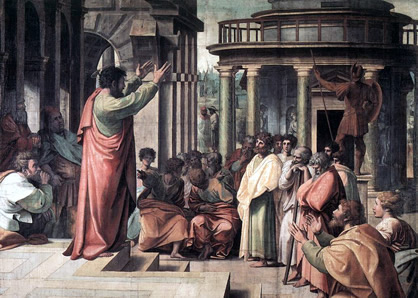Tarsus Acts 9:11;9:30;11:25;21:39;22:3
Tarsus was the capital of the Roman Province of Cilicia, situated
between the Taurus Mountains and the Mediterranean Sea. The Province
of Cilicia varied between 30 to 60 miles wide and was about 300
miles long. The city of Tarsus was about 10 miles inland of the
Mediterranean on the alluvial plain, watered by the Cydnus and may
have had as many as one half million inhabitants in the time of St.
Paul. Ramsey described the city as about 70 feet above sea level on
a level plain.
The lower Cyndus was made navigable and a port had been built to
carry goods to and from the sea. A major road lead to the north where the famous mountain
pass known as the Cilician Gates lay less than 29 miles inland. Sir
William Ramsey described the pass as one of the most famous and
important passes in history.
the sea. A major road lead to the north where the famous mountain
pass known as the Cilician Gates lay less than 29 miles inland. Sir
William Ramsey described the pass as one of the most famous and
important passes in history.
The origins of the city are shrouded in mystery, but it appears the
city was a native Cilician town taken over by Ionian settlers of
antiquity. Josephus attributes the city to the Tarshish of Genesis
10:4, but this is by no means certain. It is mentioned several
places in historical record with certainty. The Black Obelisk of
Shalmaneser says this city was taken by the Assyrians (mid C9 BCE).
Xenophon passed through in 401 BCE, and found the ruler to be a
local. Alexander found the rulership in the hands of the Persians,
and he replaced the ruler (334 BCE).
Coins found in excavations of the region make no claim of autonomy
until after the defeat of Antiochus the Great at the hands of the
Romans (189 BCE). Syria appears to have undergo ne
some reorganization at this time, allowing autonomy in some of the
regions. Tarsus appears to have grown into autonomy at this time
establishing a constitution as a free city. The city became part of
the Roman Empire with the arrival of Pompey the Roman General and
the defeat of the pirates that often harassed the city by about 64
BCE.
ne
some reorganization at this time, allowing autonomy in some of the
regions. Tarsus appears to have grown into autonomy at this time
establishing a constitution as a free city. The city became part of
the Roman Empire with the arrival of Pompey the Roman General and
the defeat of the pirates that often harassed the city by about 64
BCE.
Some scholars speculate that St. Paul may be a descendant of some of
those who were promised free citizenship if they moved to the
Cilician city in 171 BCE. Another claim for the citizenship ancestry
of St. Paul can be found in some who raise the possibility that St.
Pauls father or grandfather helped Marc Antony (and thus Rome)
during Cleopatras renowned visit to Tarsus in 41 BCE.
The historian Strabo mentions the splendor of the event, as
Cleopatra sailed her gilded barge in the Cyndus into the city. In
addition, there is reason to believe that Antony and Octavian used
some resources of the city in their struggle against Brutus and
Cassius, who they later defeated at Philippi in Macedonia. Some have
even suggested that a tent makers gift could have been rep aid
in citizenship (cp. Acts 18:3), though this is mere speculation.
aid
in citizenship (cp. Acts 18:3), though this is mere speculation.
Autonomy meant that Tarsus was able to govern itself under its own
laws, impose import taxation and a variety of other freedoms. Strabo
mentions that the city was excited by education, and was home to the
third largest university, after Athens and Alexandria. One teacher
or note that came from Tarsus was the famous Athenodorus, a Stoic
Philosopher that tutored Augustus at Apollonia, and later became his
advisor from 44 to 15 BCE.
This probably accounts for Augusts favor on the city. Athenodorus
returned to Tarsus and established a reform to the city in15 BCE.
Along with the reforms, he established a patrician class that
probably included the family of St. Paul, who boasts of his
association with the city (Acts 21:39).
In addition to being the hometown of St. Paul (Acts 9:11; 21:39;
22:3), it was also the city
 St.
Paul returned to after his escape from Jerusalem (Acts 9:30).
Barnabas found St. Paul in the city and enlisted him to service at
Antioch (Acts 11:25ff). St. Paul may well have visited on the Second
and Third Mission Journeys (Acts 15:41; 18:22-23).
St.
Paul returned to after his escape from Jerusalem (Acts 9:30).
Barnabas found St. Paul in the city and enlisted him to service at
Antioch (Acts 11:25ff). St. Paul may well have visited on the Second
and Third Mission Journeys (Acts 15:41; 18:22-23).
Biblical Sites in Turkey List


